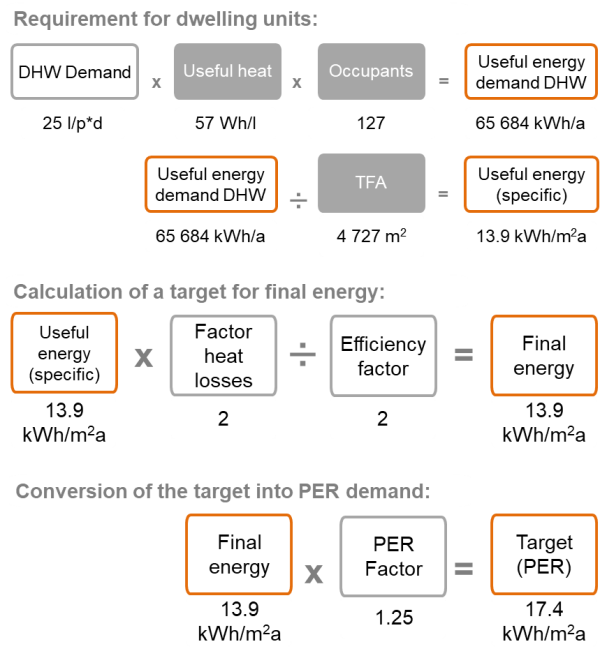Renewable primary energy demand in residential buildings with high energy intensity

© PHI
Primary energy is the amount of energy that must be generated originally in order to meet the total energy demand of a building. The conventional Primary Energy (PE) concept takes into account the fossil fuel source of energy, while the concept of Primary Energy Renewable (PER) expresses the amount of renewable energy needed, including storage losses (see more here). For building certification according to the international Passive House Standard there are fixed PER demand criteria: 60 kWh/(m²a) for Classic, 45 kWh/(m²a) for Plus and 30 kWh/(m²a) for Premium. However, in case of special uses with high energy intensity, the certification criteria [PHI 2016] states the possibility for exemptions where there is an efficient use of electrical energy for all significant devices and systems.
For residential buildings with small dwelling units (high density) such an exemption becomes more likely. The energy demand of uses such as ventilation, domestic hot water and electricity for household appliances scales with the number of people, and will thus result in a higher specific energy demand (kWh/m²a) in a high density building. In other words, the project may exceed the given threshold simply because there are more people per treated floor area. In some cases, this may happen even if highly energy efficient appliances or equipment are installed. Figure 1 shows how the specific final energy demand varies with changing dwelling sizes.
As density increases, it may not be possible to achieve a demand below 60 kWh/m2a without improving the performance of the building components beyond the values that are usual for a Passive House Classic. In order to appropriately recognize the impact of density in the specific primary energy demand, a revised threshold for high density buildings is needed. This threshold can be calculated by setting specific targets per individual energy use which are based on the expected performance of Passive Houses.
For example, for ventilation:
- The required air change for a residential building can be determined based on the recommendations for Passive Houses: 30 m³/h per person, requirement for extract zones (bathrooms, kitchen) or at least an air change of 0.3/h. The criteria for certification of ventilation units sets a maximum electricity demand of 0.45 Wh/m³
With those two values, a limit for the final energy demand for ventilation of a given building can be set:
- This value in turn can be multiplied by the relevant PER factor, to be converted into the equivalent renewable primary energy demand.
Figure 2 illustrates an example of this calculation for ventilation:
In case of Domestic Hot Water, the process would be similar, with the energy demand being determined by the fixed value for Passive Houses (25l/person*day at 60°C) and the number of occupants. Final energy is based on a limit for distribution losses of 100% of the useful energy if a very efficient heat source is used (SPF of 2 or more). The lower the efficiency of the system for DHW, the more the distribution heat losses must be reduced. Figure 3 illustrates the calculation for the same building used in Figure 2.
This process is carried out for every energy use in the building, so that:
- The targets for cooling and heating demand are based on the limits for useful energy as set on the criteria.
- The targets for ventilation, domestic hot water, and electricity are adjusted based on the requirements per person already set in PHPP, thus adjusted with density.
- Other targets such as electricity demand from the elevator, equipment, lighting, are based on project characteristics.
Read more about the targets set per energy use and the verification of the calculation for the revised target here.
Once the targets for each end use are set, these can be added to obtain the total limit for the Primary Energy Renewable demand or the Primary Energy demand of a given project. Figure 4 shows the adjustment in the PER demand as the dwelling size decreases, for a location where the cooling demand is 15kWh/m²a.1)
This methodology to calculate an exemption to the criteria for the PE/PER demand has been implemented in a tool that can be linked to a PHPP (version 9.6 or newer) and can be used for residential projects. Projects seeking certification can use the original limits as set out in the Passive House criteria or the revised limit as calculated with the tool. The tool was released on September of 2019 for its implementation on a pilot phase. Projects seeking an exemption to the criteria for PE/PER demand must be reviewed by an accredited Building Certifier to obtain a revised limit for the PE/PER demand.
This article was developed in the framework of the “Project-specific PER” project. This project was administered by the Zero Emissions Building Exchange with funding from the City of Vancouver, Natural Resources Canada and the BC Ministry of Energy, Mines and Petroleum Resources.



